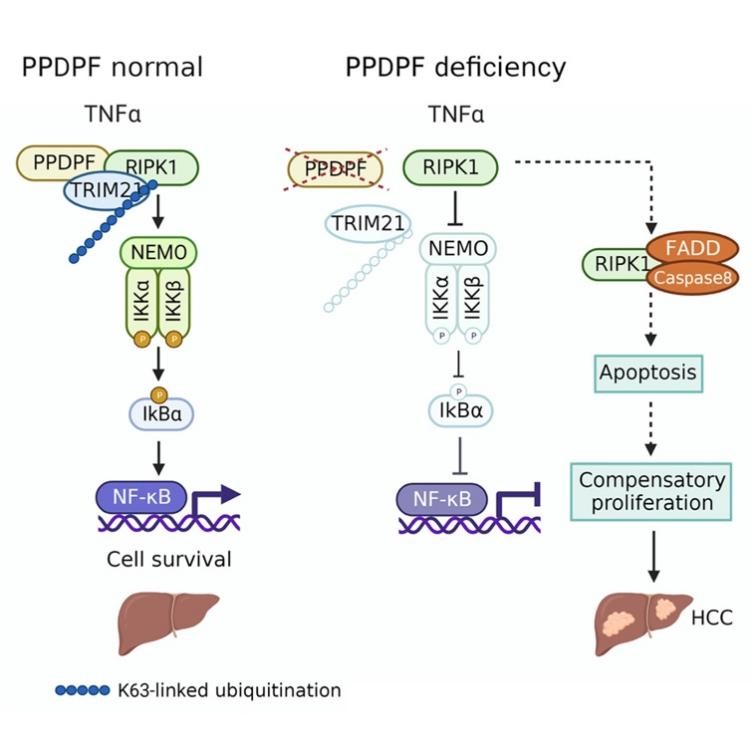Researchers Reveal Roles of PPDPF in Hepatocellular Carcinoma Development
A recent study by Dr. XIE Dong’s group from the Shanghai Institute of Nutrition and Health (SINH) of the Chinese Academy of Sciences revealed the important role of PPDPF in the development of HCC and provided a potential therapeutic strategy for hepatocellular carcinoma. This work entitled “PPDPF suppresses the development of hepatocellular carcinoma through TRIM21-mediated ubiquitination of RIPK1” was published online in Cell Reports on Apr. 5th, 2023.
Liver cancer is one of the most common malignant tumors, and its incidence and mortality are increasing year by year worldwide, becoming a major health problem threatening human beings. Hepatocellular carcinoma (HCC) is the most common primary liver malignancy. Hepatocellular carcinoma has a complex pathogenesis, and is influenced by multiple risk factors. Despite considerable advances in the treatment of HCC in recent years, the prognosis of patients with HCC remains very poor. Therefore, the development of new effective therapeutic strategies is urgently needed.
Pancreatic progenitor cell differentiation and proliferation factor (PPDPF) consists of 114 amino acids, and the gene locates on chromosome 20. Expdf, a homolog of PPDPF, was first reported as a key regulator of exocrine pancreas development in zebrafish. In recent years, it has been suggested that PPDPF may play an important role in cancer. However, the biological functions and related molecular mechanisms of PPDPF in HCC have not yet been comprehensively elucidated.
In the current study, researchers from SINH found that the expression of PPDPF was downregulated in HCC. Decreased PPDPF expression was correlated with poorer survival. Liver-specific depletion of Ppdpf in mice inhibited the activation of NF-κB signaling and promoted apoptosis and compensatory proliferation in the DEN-induced HCC mouse model, which ultimately resulted in accelerated progression of HCC.
Mechanistic studies revealed that PPDPF interacted with RIPK1 and promoted K63-linked ubiquitination of RIPK1, which facilitated the activation of NF-κB signaling. Furthermore, the researchers identified TRIM21 as the E3 ligase responsible for the ubiquitination of RIPK1 on K140 residue by use of mass spectrometry analysis.
Moreover, the researchers detected a positive correlation between PPDPF expression and p-P65, the marker of NF-κB activation in clinical samples.
Overall, these findings have identified PPDPF as a regulator of NF-κB signaling and provided a potential therapeutic candidate for HCC.
Dr. WANG Yi-Kang, MA Ning and Ph.D student XU Sheng are the first authors, and Dr. XIE Dong and Dr. LI Jing-Jing are the corresponding authors of this publication. The study was funded by the grants from National Natural Science Foundation of China and Youth Innovation Promotion Association of CAS.

Schematic representation demonstrating the molecular mechanism of PPDPF in regulating development of HCC. (Image provided by Dr. XIE Dong's group)
Media Contact:
WANG Jin
Shanghai Institute of Nutrition and Health,
Chinese Academy of Sciences
Email: wangjin01@sinh.ac.cn
Web: http://english.sinh.cas.cn/
